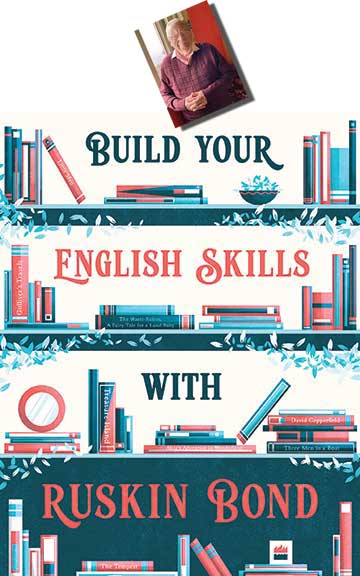Chintan Girish Modi
Ruskin Bond, who turned 89 earlier this year, is loved by generations of children who have grown up in India. The author has written across a variety of genres, painting memorable portraits of life in the mountains and small towns with his gift for storytelling.

Build Your English Skills with Ruskin Bond is a collection of poems, short stories and extracts from novels that can be used to introduce students to literary classics. None of these have been written by Bond himself, so the title could be seen as misleading. While this book, published by HarperCollins India, does not specify the age group that it is meant for, it could be used with students from grades 6 to 8 in schools that follow English as the medium of instruction.
The poems presented here are Christina Rossetti’s “Who Has Seen the Wind?”, Robert Louis Stevenson’s “From a Railway Carriage”, Emily Dickinson’s “‘Hope’ Is the Thing with Feathers”, Edward Lear’s “The Quangle Wangle’s Hat”, Edgar Albert Guest’s “Hard Luck”, Walter de la Mare’s “Silver”, William Wordsworth’s “The Solitary Reaper”, Rudyard Kipling’s “The Way Through the Woods”, and Robert Southey’s “The Battle of Blenheim”.
As far as fiction is concerned, the book has extracts from novels like Charles Kingsley’s The Water-Babies, A Fairy Tale for a Land Baby, Lewis Carroll’s Alice’s Adventures in Wonderland, Charles Dickens’ David Copperfield, Robert Louis Stevenson’s Treasure Island, Jerome K Jerome’s Three Men in a Boat, Louisa May Alcott’s Little Men, Jonathan Swift’s Gulliver’s Travels, and Rudyard Kipling’s Kim. In addition to these, the book has three short stories – Sir Arthur Conan Doyle’s “The Mystery of the Test Papers”, Saki’s “The Open Window”, and Guy de Maupassant’s “The Piece of String” – and an extract from William Shakespeare’s play “The Tempest” featuring a conversation between Miranda and Prospero.
In the introduction, Bond clarifies that the book aims to help students “appreciate the English language” and “acquire fluency in it”. He adds, “At the same time, we hope its content will help to inculcate in the reader a love for reading, for literature, and for good writing.” These texts are undoubtedly significant because they are a part of the canon of English literature. However, the canon needs to be interrogated and revised in a postcolonial context like ours.
The selection seems quaint and outdated in 2023, almost as if the school curricula have not changed in the last few decades. I expected to see at least a few texts from India in a book for Indian students. We have some fine poetry and prose written by Indians in English, which are suitable for inclusion in such a book. Their complete absence is too glaring to be an oversight. I am not sure why Bond, and the editors of this book, chose to restrict their definition of classics and their imagination of literary output in the English language.
The book does mention Indian authors RK Narayan and Vijay Tendulkar under suggestions for further reading but extracts from their work are not used. The extent to which Bond was part of putting together this book is not clear. Some of his “reading favourites” appear here but he also notes that the editorial team at HarperCollins India helped him make the selection.
In the introduction, Bond writes, “In the course of the last 100 years, the English language has taken root in many parts of the world, including India.” He calls it the language of science, commerce, diplomacy and international communication, and remarks that fluency in English – in terms of writing and speaking – would give students an advantage over others. The fact that English was imposed by the colonial education system has been glossed over.
The texts are accompanied by short biographical sketches of the authors and poets. They are followed by glossaries, questions to aid comprehension, discussion prompts, notes on language use, and reading recommendations. This book draws students’ attention to elements of writing such as tone of voice, structure, imagery, similes, metaphors, rhyme, meter, repetition, alliteration, personification, and idiomatic expressions. It engages students in guessing meanings of words from the context instead of looking them up on Google Search.
Teachers who pick up the book expecting it to do justice to all the language skills – listening, speaking, reading, and writing – might feel disappointed. There are hardly any creative writing and listening exercises. The “For Discussion” section offers some practice in developing speaking skills but the questions after the texts seem to be hastily put together. Many of them can be answered with a Yes or a No. For example, after the extract from Alice’s Adventures in World, students are asked, “Do you think Alice is really in a magical place?” and “Do the events in the story make any sense at all?” Here they are not asked to share the reason behind their response. Open-ended questions would have enabled richer discussion.
Students are invited to think of how language changes over time, to come up with alternative titles for texts, and to create additional stanzas for existing poems but they do not get to learn much about character development, point of view, setting, plot, and dialogue. It is unlikely that Bond wrote up the prompts and tasks placed after the texts because a curriculum designer would be most suitable for such work. Since no author has been credited, it seems reasonable to assume that these were created by the editorial team. This book could have been better if the publishers had put more thought, effort, and care into producing it.
Note: The book is priced at Rs. 399.
The author is a journalist, writer and educator with an M.Phil. in English language education. He can be reached at chintan.writing@gmail.com.
